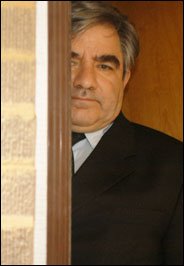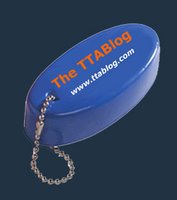In the fifteen months since the CAFC's decision in
Bose, the TTAB has yet to find fraud. Moreover, given the subjective nature of the "intent" issue, the chances of the Board finding fraud on summary judgment are very slim to nil. Witness the

Board's interlocutory ruling in this proceeding, in which Petitioner Factory Mutual seeks to cancel a registration for the
F & Design mark shown to the right, for metal fasteners, claiming ownership of ten registrations for eight different certification marks (including the five design marks shown below) relating to product safety and testing services for manufacturers.
Factory Mutual Insurance Company and FM Approvals LLC v. Fullco Industries, Inc., Cancellation No. 92050758 (December 17, 2010) [not precedential].

Factor Mutual moved for summary judgment on the ground of fraud, alleging (1) that Respondent Fullco, in its Section 15 incontestability declaration, made a material false statement, and (2) that Fullco, when it filed its original application, claimed use of its mark on goods for which it had admittedly not used the mark.
Section 15 Declaration: On March 22, 2010, Fullco filed a combined Section 8 and 15, averring that “there is no proceeding involving said rights [to the mark in its Registration No. 2830118] pending and not disposed of either in the U.S. Patent and Trademark Office or in the courts.” Factory Mutual immediately moved to add a fraud claim to its cancellation petition, contending that this statement is "manifestly false" because the instant proceeding was filed nearly a year earlier. Fullco promptly filed a request to withdraw "the inadvertently filed Section 8 and 15 declaration" and replaced it with a Section 8 declaration that does not contain the same language. [
i.e., Fullco dropped the Section 15 claim].
Fullco asserted that the false statement was the result of an innocent mistake and that it immediately sought to correct it when it first learned of the error via Petitioner's filing of the motion to amend. [Did someone fill out the wrong electronic form and send it to the client, who blindly signed it? -
ed.]
The Board granted Factory Mutual's motion to add the fraud claim, but denied its summary judgment motion as to this issue. It agreed that the statement regarding "no other USPTO proceeding involving respondent’s rights in the mark" was false. Moreover, "the false statement is material inasmuch as, if not corrected, the registration acquires incontestable status."
The Board found this case analogous to the pre-
Bose cases where "an applicant, prior to publication of its opposed application, corrected a misstatement regarding the identification of goods in the application.
University Games Corp. v. 20Q.net Inc., 87 USPQ2d 1465 (TTAB 2008). The Board found that this correction, occurring before publication of the mark, 'constitutes a rebuttable presumption that opposer lacked the willful intent to deceive the Office.'"
Here, the Board reasoned, Fullco's correction of the statement "prior to the USPTO’s acknowledgment of the Section 15 declaration serves as [gives rise to? -
ed.] a rebuttable presumption that applicant’s intent was not to fraudulently mislead the USPTO. Petitioners have not overcome that presumption." And so the Board denied this part of the summary judgment motion.
TTABlog comment: This "rebuttable presumption" arising out of a filing "prior to the USPTO's acknowlegement" theory seems inappropriate here because a Section 15 declaration is effective on filing. (See Section 15(3) of the Trademark Act). Although Section 15 states that "The Director shall notify any registrant who files the above-prescribed affidavit of the filing thereof," nothing in Section 15 says that the declaration is effective only upon PTO acknowledgement of the filing. In other words, once filed, the Section 15 affidavit appears to be a done deal and the registration is at that point incontestable, regardless of whether the PTO acknowledges receipt of the filing.
It seems to me that the Board should have simply said that Respondent's claim of innocence raised a factual issue that precluded summary judgment. Forget the presumption here.
Non-use or Fraud: Factory Mutual relied on the deposition testimony of Fullco's president and CEO, wherein "he appears to state that the mark was never used with positive displacement pumps," and on an internal memo regarding the making of a "label" bearing the mark.
Fullco supplied a declaration and argued that "Mr. Fuller did not complete his deposition, and did not fully understand what was being asked." T\the memo was "taken out of context" and that and "there is no reason to believe [the author] incorrectly represented use of the mark to the USPTO."
Respondent disputes that it was not using its mark on all of the goods at the time of application and avers that it was using the mark with all of the goods consistent with its application. Respondent clarifies that the confusion came during the deposition because at one time the mark was on the packaging and then later was actually on the goods, except the positive displacement pumps which due to their design could only have the mark on the packaging, and a difference in understanding as to whether "positive displacement pumps" are encompassed by the product headings "machined part" or "hydraulics products."
The Board concluded that "there are genuine issues of material fact as to whether the mark was used on the goods at the time of filing the application, and respondent’s intent to commit fraud."
TTABlog further comment: This case well illustrates two obvious arguments in defending against a fraud summary judgment motion: (1) the allegedly false statement was not false; and (2) any error was inadvertent and innocent. Of course, provide a declaration to support your arguments. Either argument will likely create a genuine issue of material fact that will preclude the granting of a summary judgment motion.
TTABlog question: Section 15 incontestability relates to the right to use a mark, not the right to register. [Section 14 sets a five-year statute of limitations for challenging a registration, except for certain excepted grounds, regardless of whether the registration has been made incontestable.] Is the effect of Section 15 limited to civil actions? What role, if any, does incontestability play in TTAB proceedings? Is a registration (or mark) stronger because it is incontestable? Is it material to the PTO whether a registered mark is incontestable or not (other than the fact that the PTO must acknowledge receipt)?
Text Copyright John L. Welch 2010.
































